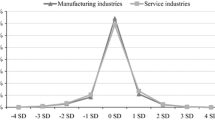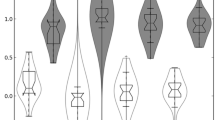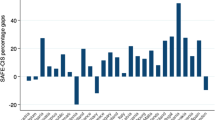Abstract
Theoretical models suggest that standardisation activities in the market may be too high or too low with respect to the market optimum. This paper investigates the association of standardisation engagement with firms’ performance as indirect evidence of a sub-optimal level of market standardisation activities. Anecdotal evidence has it that firms can benefit from engagement in standardisation activities, but large quantitative studies on this topic are rather scarce. Based on a large innovation survey, this paper implements matching models to compare outcomes of firms with similar features but different standardisation activities. The outcomes of interest are several measures of innovation and growth. Standardisers and non-standardisers are matched onto a rich set of control variables. Firms engaged in standardisation have better innovation performance than firms with no such activities. However, the results for the performance measures are rather mixed, showing no association or negative association with labour productivity measures. Heteroscedasticity-based instruments mitigate possible endogeneity issues. These results can be interpreted as indirect evidence of low standardisation activity in the market, possibly due to long payback periods and appropriability issues of the standardisation investment.

Similar content being viewed by others
Notes
A firm that seeks to “identify, analyse, and respond to the strengths, weakness, and strategies of its current and potential competitors” (Zhang et al., 2020, p.883).
A “firm’s ability and will to acquire new technologies and use them in new product development” (Zhang et al., 2020, p.883).
According to ETSI (2019), “‘essential’ as applied to IPR means that it is not possible on technical (but not commercial) grounds, taking into account normal technical practice and the state of the art generally available at the time of standardisation, to make, sell, lease, otherwise dispose of, repair, use or operate Equipment or Methods which comply with a Standard without infringing that IPR”.
See e.g. Jakobs (2020) for a discussion of this aspect.
Luxembourgish firms participate in international standardisation through ILNAS, which represents Luxembourg within international standardisation organisations. ILNAS represents Luxembourg in CEN (European Committee for Standardization), CENELEC (European Committee for Electrotechnical Standardization), ISO (International Organization for Standardization) and IEC (International Electrotechnical Commission). As firms can directly contribute to ETSI (European Telecommunications Standards Institute) and ITU (International Telecommunication Union) without the coordination by ILNAS, the analysis also considers Luxemburgish firms participating in these standards developing organisations.
In the early research stages, some efforts were made to separately investigate internal and external standardisation (Riillo, 2013b). However, the results were not stable because of the low number of firms engaged in external standardisation.
Breusch-Pagan test suggests that unweighted data also meet the heteroscedasticity assumption. Note that heteroscedasticity arises naturally in a setting with endogenous binary regressor and in the case of weighted survey data. The not rejection of the Kleibergen-Paap test suggests that innovation measures may be under-identified, and the rejection of the Hansen J-statistic raises doubt about the instruments’ validity in case of added value growth and Added value per emp. growth.
References
Acemoglu, D., Gancia, G., & Zilibotti, F. (2012). “Competing engines of growth: Innovation and standardisation,“. Journal of Economic Theory, 147(2), 570–601e3
Aggarwal, V. A., & Hsu, D. H. (2014). “Entrepreneurial exits and innovation”. Management Science, 60(4), 867–887
Archer, K., & Lemeshow, S. (2006). ‘Goodness-of-fit test for a logistic regression model fitted using survey sample data’, The Stata Journal, 6(1), pp. 97–105. Available at: http://ideas.repec.org/a/tsj/stataj/v6y2006i1p97-105.html (Accessed: Mar 26 2014)
Asikainen, A. (2008). “Innovation and Productivity in Luxembourg” Économie et Statistiques, STATEC Working papers n° 23, April 2008, Luxembourg, available at: http://www.innovation.public.lu/html/publication/
Azoulay, P., Stuart, T., & Wang, Y. (2014). Matthew: Effect or fable? Management Science, 60(1), 92–109
Baron, J., & Schmidt, J. (2014). “Technological Standardisation, Endogenous Productivity and Transitory Dynamics” Working paper no. 503, Banque de France. Available at http://julia-schmidt.org/Tech_shocks_Schmidt.pdf
Baron, J., Li, C., & Nasirov, S. (2019). “Why do R&D-intensive firms participate in standards organisations? The role of patents and product-market position,“ 2019, Accessed: Jan 21, 2022. [Online]. Available: https://econpapers.repec.org/RePEc:not:notgep:2019-16
Baron, J., Ménière, Y., & Pohlmann, T. (2014). Standards, consortia, and innovation. International Journal of Industrial Organization, 36, 22–35. doi: https://doi.org/10.1016/j.ijindorg.2014.05.004
Bekkers, R., Duysters, G., & Verspagen, B. (2002). Intellectual property rights, strategic technology agreements and market structure the case of GSM. Research Policy, 31(7), 1141–1161. doi: https://doi.org/10.1016/S0048-7333(01)00189-5
Blackwell, M., Iacus, S., King, G., & Porro, G. (2009). CEM: Coarsened exact matching in Stata.Stata Journal, (4), pp.524–546
Blind, K. (2013). The Impact of Standardisation and Standards on Innovation, Report within the MIoIR-NESTA Compendium of Evidence on Innovation Policy, Manchester Institute of Innovation Research, Feb 2013, http://www.nesta.org.uk/sites/default/files/the_impact_of_standardization_and_standards_on_innovation.pdf
Blind, K. (2002). Driving forces for standardisation at standardisation development organisations. Applied Economics, 34(16), 1985–1998
Blind, K. (2004). The economics of standards: theory, evidence, policy. Northampton, Massachusetts: Edward Elgar Publishing
Blind, K. (2006). ‘Explanatory factors for participation in formal standardisation processes: Empirical evidence at firm level’. Economics of Innovation and New Technology, 15(2), 157–170. doi: https://doi.org/10.1080/10438590500143970
Blind, K., & Großmann, A. (2014). : An Exploratory Analysis of Company Standards - Evidence from the German Standardisation Panel; EURAS Proceedings 2014, I. Mijantovic and K. Jakobs (Eds.), ISBN 3-86073-305-3, pp. 33–47
Blind, K., & Mangelsdorf, A. (2013). ‘Alliance Formation of SMEs: Empirical Evidence From Standardization Committees’. IEEE Transactions on Engineering Management, 60(1), 148–156. doi: https://doi.org/10.1109/TEM.2012.2192935
Blind, K., & Mangelsdorf, A. (2016). ‘Motives to standardise: Empirical evidence from Germany’, Technovation, 48–49, pp. 13–24. doi: https://doi.org/10.1016/j.technovation.2016.01.001
Blind, K., & Thumm, N. (2004). ‘Interrelation between patenting and standardisation strategies: empirical evidence and policy implications’. Research Policy, 33(10), 1583–1598. doi: https://doi.org/10.1016/j.respol.2004.08.007
Blind, K., & von Laer, M. (2021). “Paving the path: drivers of standardisation participation at ISO,“. Journal of Technology Transfer, 1–20. doi:https://doi.org/10.1007/S10961-021-09871-4/TABLES/4
Blind, K., Lorenz, A., & Rauber, J. (2021). “Drivers for Companies’ Entry into Standard-Setting Organizations,” IEEE Trans. Eng. Manag., vol. 68, no. 1, pp. 33–44, Feb. 2021, doi: https://doi.org/10.1109/TEM.2020.2975427
Blind, K., De Vries, H., & Mangelsdorf, A. (2012). ‘External Knowledge Sourcing and Involvement in Standardisation - Evidence from the Community Innovation Survey’, in 2012 IEEE International Technology Management Conference, ITMC 2012, art. no. 6306399, pp. 1–9
Blind, K., Ramel, F., & Rochell, C. (2021). The influence of standards and patents on long-term economic growth. Journal of Technology Transfer, 1–21. doi:https://doi.org/10.1007/S10961-021-09864-3/TABLES/5
Carpenter, D., Chattopadhyay, J., Moffitt, S., & Nall, C. (2012). The Complications of Controlling Agency Time Discretion: FDA Review Deadlines and Postmarket Drug Safety. American Journal of Political Science, 56(1), 98–114
Cohen, W. M., & Levinthal, D. A. (1990). Absorptive capacity: a new perspective on learning and innovation. Administrative Science Quarterly, 35(1), 128–152
David, P., & Greenstein, S. (1990). The Economics of Compatibility Standards: An Introduction To Recent Research. Economics of Innovation and New Technology, 1(1), pp. 3–41
De Vries, H. J. (2006). Standards for business: How companies benefit from participation in international standards-setting. IEC, Geneva, Switzerland, available at http://www.iec.ch/about/globalreach/academia/pdf/vries-1.pdf accessed 31/7/2014
Demortain, D. (2008). ‘Standardising through concepts: the power of scientific experts in international standard-setting. Science and Public Policy, 35(6), 391–402. doi: https://doi.org/10.3152/030234208X323325
Deng, X., Li, Q. C., & Mateut, S. (2022). Participation in setting technology standards and the implied cost of equity. Research Policy, 51(5), 104497
Dolton, P., & Smith, J. (2011). The Impact of the UK New Deal for Lone Parents on Benefit Receipt. IZA Discussion Paper No. 5491. Available at http://ftp.iza.org/dp5491.pdf accessed 31/7/2014
Dugoff, E., Schuler, M., & Stuart, E. (2014). ‘Generalising observational study results: applying propensity score methods to complex surveys. Health Services Research, 49(1), 284–303
Egyedi, T. (2003). Consortium problem redefined: Negotiating democracy in the actor network on standardisation. International Journal of IT Standards and Standardization Research, 1(2), 22–38. DOI: https://doi.org/10.4018/jitsr.2003070102
ETSI (2022). : Intellectual Property Rights (IPRs); Essential, or potentially Essential, IPRs notified to ETSI in respect of ETSI standards.ETSI SR000 314 V2.31.1. https://www.etsi.org/deliver/etsi_sr/000300_000399/000314/02.31.01_60/sr_000314v023101p.pdf
EU Commission (2008). Communication n. 133 From The Commission To The Council, The European Parliament And The European Economic And Social Committee: Towards an increased contribution from standardisation to innovation in Europe
Eurostat (2003). The new SME definition User guide and model declaration” http://ec.europa.eu/enterprise/policies/sme/files/sme_definition/sme_user_guide_en.pdf
Eurostat (2013). “National accounts and GDP” - Statistics Explained (2013/11/5) http://epp.eurostat.ec.europa.eu/statistics_explained/index.php/National_accounts_%E2%80%93_GDP
Farrell, J., & Saloner, G. (1985). Standardisation, compatibility, and innovation.The RAND Journal of Economics, pp.70–83
Farrell, J., & Saloner, G. (1986). Standardisation and variety. Economics Letters, 20(1), 71–74
Farrell, J., & Saloner, G. (1988). Coordination Through Committees and Markets. RAND Journal of Economics, 19(2), 235–252
Gandal, N., Gantman, N., & Genesove, D. (2007). In S. Policy, V. Greenstein, & Stango (Eds.), Intellectual Property and Standardization Committee Participation in the US Modem Industry in Standards and Public (pp. 208–230). New York, NY: Cambridge University Press
Graz, J. C. (2019). The Power of Standards. Cambridge University Press
Heckman, J. J., & Todd, P. E. (2009). A Note on Adapting Propensity Score Matching and Selection Models to Choice Based Samples. The econometrics journal, 12(1), S230–S234
Heckman, J. J. (2008). Econometric Causality. International Statistical Review, 76(1), 1–27
Ho, J. Y., & O’Sullivan, E. (2015). The evolving role of standardisation in technological innovation: The case of photovoltaics. IEEE-SIIT 2015. The 9th International Conference on Standardization and Innovation in Information Technology, Sunnyvale, CA, 6–8 October 2015
Hussinger, K., & Pacher, S. (2019). ‘Information ambiguity, patents and the market value of innovative assets’. Research Policy, 48(3), 665–675. doi: https://doi.org/10.1016/J.RESPOL.2018.10.022
Iacus, S. M., King, G., & Porro, G. (2011). Multivariate Matching Methods That Are Monotonic Imbalance Bounding. Journal of the American Statistical Association, 106(493), 345–361
Iacus, S. M., King, G., & Porro, G. (2012). Causal Inference without Balance Checking: Coarsened Exact Matching. Political Analysis, 20(1), 1–24
Iizuka, M., & Ikeda, Y. (2021). Regulation and innovation under the 4th industrial revolution: The case of a healthcare robot. HAL by Cyberdyne Technovation, 108, 102335
ILNAS (2014). Policy on participation in technical standards committees. Available at https://portail-qualite.public.lu/dam-assets/fr/documentations/normes-normalisation/delegue-normalisation/ilnas-oln-P001-politique-participation-comite-technique/ilnas-oln-p001-politique-participation-comite-technique-fr.pdfaccessed 19/5/2022
Jakobs, K. (2020). Responsibility by Design?! – On the Standardisation of ‘Smart’ Systems. In J. S. Gordon (Ed.), Smart Technologies and Fundamental Rights (pp. 285–315). Brill
Jakobs, K., Procter, R., & Williams, R. (2001). The Making of Standards: Looking Inside the Work Groups. IEEE Communications Magazine, 39(4), 102–107
Jakobs, K., Lemstra, W., Hayes, V., Tuch, B., & Links, C. (2010). Creating a Wireless LAN Standard: IEEE 802.11. In W. Lemstra, J. Groenewegen, & V. Hayes (Eds.), The Innovation Journey of WiFi (pp. 53–109). Cambridge: Cambridge University Press
Jungmittag, A., Blind, K., & Grupp, H. (1999). “Innovation, Standardization and Long-term Production Function“ Zeitschrift für Wirtschaft und Sozialwissenschaften (ZWS)119pp. 205–222
Kalton, G., & Piesse, A. (2007). “Survey research methods in evaluation and case-control studies”. Statistics in medicine, 26,(8), 1675–1687
Kang, B., & Bekkers, R. (2015). Just-in-time inventions and the development of standards. Research Policy, 44(10), 1941–1961
Kang, B., & Motohashi, K. (2015). Essential intellectual property rights and inventors’ involvement in standardisation. Research Policy, 44(2), 483–492
Katz, M. L., & Shapiro, C. (1986). Product Compatibility Choice in a Market with Technological Progress. Journal of Political Economy, 95, 822–841
King, G., Nielsen, R., Coberley, C., Pope, J. E., & Aaron Wells. (2011). and. Comparative Effectiveness of Matching Methods for Causal Inference. Available at http://gking.harvard.edu/files/gking/files/psparadox.pdf accessed 31/7/2014
Kwon, S. (2008). Does the standardisation process matter? A study of cost-effectiveness in hospital drug formularies. Management Science, 54(6), 1065–1079
Lambert, R., & Temple, P. (2015). The Relationship between Standards, Standards Development and Intellectual Property. British Standards Institution
Layne-Farrar, A., & Padilla, A. J. (2011). Assessing the Link Between Standards and Patents. International Journal of IT Standards and Standardization Research, 9(2), 19–49
Leiponen, A. E. (2008). Competing through cooperation: The organisation of standard-setting in wireless telecommunications. Management Science, 54(11), 1904–1919
Lenihan, H., McGuirk, H., & Murphy, K. R. (2019). Driving innovation: Public policy and human capital. Research Policy, 48(9), 103791. doi: https://doi.org/10.1016/j.respol.2019.04.015
Lerner, J., & Tirole, J. (2006). A Model of Forum Shopping. The American Economic Review, 96(4), 1091–1113
Leuven, E., & Sianesi, B. (2003). PSMATCH2: Stata module to perform full Mahalanobis and propensity score matching, common support graphing, and covariate imbalance testing”. Available at http://ideas.repec.org/c/boc/bocode/s432001.html accessed 28/11/2013
Lin, D. (2003). Dual tragedies: IP rights in industry standards. Computer, 36(2), 25–27
Link, A. N. (1983). Market structure and voluntary product standards. Applied Economics, 15(3), 393–401
Lorenz, A., Raven, M., & Blind, K. (2019). “The role of standardisation at the interface of product and process development in biotechnology,“. Journal of Technology Transfer, 44(4), 1097–1133. doi:https://doi.org/10.1007/S10961-017-9644-2/FIGURES/4
Mattli, W., & Büthe, T. (2011). The New Global Rulers: The Privatisation of Regulation in the World Economy. Princeton, NJ: Princeton University Press
McFadden, D. (1978). Quantitative Methods for Analyzing Travel Behaviour of Individuals: Some Recent Developments, in D. Hensher and P. Stopher (eds.), Behavioural Travel Modelling, 279–318, Croom Helm London: London
Morgan, S. L., & Winship, C. (2007). Counterfactuals and Causal Inference: Methods and Principles for Social Research. New York: Cambridge University Press
Nambisan, S. (2013). Industry technical committees, technological distance, and innovation performance. Research Policy, 42(4), 928–940
O’Sullivan, E., & Brévignon-Dodin, L. (2012). Role of Standardisation in support of Emerging Technologies. available at http://www.ifm.eng.cam.ac.uk/uploads/Resources/Reports/OSullivan_Dodin_Role_of_Standardisation_June_2012__2_.pdf accessed 15/1/2015
OECD (2007). Information Economy – Sector Definitions based on the International Standard Industry Classification (ISIC 4), OECD document DSTI/ICCP/IIS(2006)2/FINAL. Available at http://www.oecd.org/sti/sci-tech/38217340.pdf, accessed the 29/05/2013
OECD (2012). Service innovation and non-technological innovation, in OECD, OECD Science, Technology and Industry Outlook 2012, OECD Publishing. doi: https://doi.org/10.1787/sti_outlook-2012-14-en
Riillo, C. A. F. (2013a). Profiles and Motivations of Standardisation Players. International Journal of IT Standards and Standardization Research, 11(2), 17–33. doi: https://doi.org/10.4018/jitsr.2013070102
Riillo, C. A. F. (2013b). The engagement in standardisation activities A firm-level analysis of formal and company standardisation. Proceedings of the 17th EURAS Annual Standardisation Conference – Boosting European Competitiveness – 24–26 June 2013 Brussels, Belgium. Available at http://www.statistiques.public.lu/catalogue-publications/economie-statistiques/2014/70-2014.pdf
Riillo, C. A. F. (2017). Beyond the question “Does it Pay to be Green?“: How much green? and when? Journal of Cleaner Production, 141(10), 626–640
Rosenbaum, P. R. (2005). Sensitivity Analysis in Observational Studies. In Encyclopedia of Statistics in Behavioral Science, edited by B.S. Everitt and D.C. Howell, 1451–1462. John Wiley & Sons, Ltd, Chichester
Rosenbaum, P. R., & Rubin, D. B. (1983). The Central Role of the Propensity Score in Observational Studies for Causal Effects. Biometrika, 70(1), 41–55
Rysman, M., & Simcoe, T. (2008). Patents and the performance of voluntary standard-setting organisations. Management Science, 54(11), 1920–1934
STATEC (2010). Community Innovation Survey 2008 (CIS 2008) Quality Report for Luxembourg available at http://www.statistiques.public.lu/fr/methodologie/methodes/entreprises/science-technologie-innovation/science-technologie-innovation/Quality-report-CIS-2008.pdf
Swann, G. M. P. (2000). The economics of standardisation: final report for Standards and Technical Regulations Directorate. Final Report for Standards and Technical Regulations Directorate Department of Trade and Industry
Tassey, G. (2000). Standardisation in technology-based markets. Research Policy, 29(4–5), 587–602
Tether, B. S., Hipp, C., & Miles, I. (2001). Standardisation and particularisation in services: evidence from Germany. Research Policy, 30(7), 1115–1138
Tukey, J. W. (1962). The future of data analysis. Annals of Mathematical Statistics, 33, 1–67
Updegrove, A. (2006). The Essential Guide to Standards, Chap. 2: Participating In Standard Setting Organisations: Value Propositions, Roles And Strategies”, available at: https://www.consortiuminfo.org/guide/participating-in-a-sso/value-propositions-roles-and-strategies
Waguespack, D. M., & Fleming, L. (2009). Scanning the Commons? Evidence on the Benefits to Startups Participating in Open Standards Development’. Management Science, 55(2), 210–223. doi: https://doi.org/10.1287/mnsc.1080.0944
Wakke, P., Blind, K., & Ramel, F. (2016). The impact of participation within formal standardisation on firm performance. Journal of Productivity Analysis, 45(3), 317–330
Wakke, P., Blind, K., & De Vries, H. J. (2015). Driving factors for service providers to participate in standardisation: Insights from the Netherlands. Industry and innovation, 22(4), 299–320
Werle, R., & Iversen, E. J. (2006). Promoting legitimacy in technical standardisation. Science Technology & Innovation Studies, 2(1), 19–39
Wiegmann, P. M., de Vries, H. J., & Blind, K. (2017). Multi-mode standardisation: A critical review and a research agenda. Research Policy, 46(8), 1370–1386
Wooldridge, J. M. (2010). Econometric Analysis of Cross Section and Panel Data, 2nd Edition Cambridge, MA: MIT Press
Zanutto, E. (2006). A comparison of propensity score and linear regression analysis of complex survey data. Journal of Data Science, 4, 67–91
Zhang, Y., Liu, J., & Sheng, S. (2020). Strategic orientations and participation intentions for technical standardisation. Technology Analysis & Strategic Management, 32(8), 881–894
Acknowledgements
The authors appreciate the feedback of the participants at 17th EURAS Annual Standardisation Conference – Boosting European Competitiveness pp. 325–340, Brussels, Belgium 24–26 June 2013; the workshop “innovation, patents and standards” Tours, France 19/11/2013; at EURAM conference, Valencia, Spain 4-7/06/2014 and in Proceeding 19th EURAS conference 8–10 September 2014, Beograd, Serbia; “ENTerprise REsearch InNOVAtion” (ENTRENOVA), Rovinj, Croatia, 8–9.09.2016; 25th EURAS Conference,Berlin, Germany; 6–8/09/2021. The authors would also like to thank anonymous referees and editors for their careful and constructive reviews. Cesare Riillo conducted the research for this paper when employed by STATEC Research A.s.b.l. ateh research department of STATEC, the National Statistical Institute of Luxembourg. Cesare A.F. Riillo gratefully acknowledges the support of the Observatoire de la Compétitivit, Ministére de l’Economie, DG Compétitivité, Luxembourg, and STATEC, the National Statistical Institute of Luxembourg. Views and opinions expressed in this article are those of the author and do not reflect those of STATEC or STATEC Research and funding partners.
Author information
Authors and Affiliations
Contributions
CR is responsible for study design, data collection, econometric analysis, figures, literature search, and writing; KJ for literature search, and writing.
Corresponding author
Additional information
Publisher’s Note
Springer Nature remains neutral with regard to jurisdictional claims in published maps and institutional affiliations.
Rights and permissions
About this article
Cite this article
Riillo, C.A., Jakobs, K. Too many or too few Standards Setters? Evidence from the Performance of Firms engaged in Standardization. J Technol Transf 48, 2106–2131 (2023). https://doi.org/10.1007/s10961-022-09951-z
Accepted:
Published:
Issue Date:
DOI: https://doi.org/10.1007/s10961-022-09951-z
Keywords
- Standardization
- Innovation
- Firm performance
- Coarsened exact matching
- Propensity score matching
- Complex survey data




